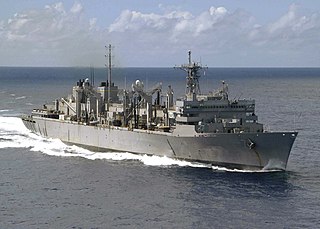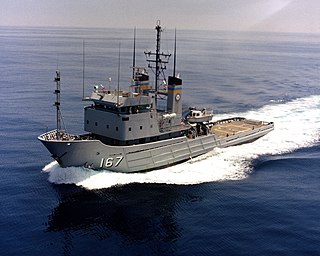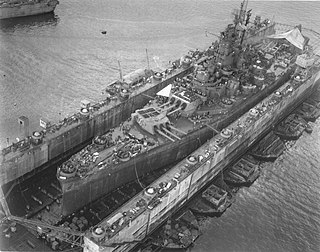
The fast combat support ship is a type of replenishment auxiliary ship. Different from traditional logistic ships, the fast combat support ship is designed with high speed to keep up with the carrier battle group/carrier strike group, while the multi-product station is capable of supplying all types of necessities for the fleet.

Puget Sound Naval Shipyard, officially Puget Sound Naval Shipyard and Intermediate Maintenance Facility, is a United States Navy shipyard covering 179 acres (0.7 km2) on Puget Sound at Bremerton, Washington in uninterrupted use since its establishment in 1891; it has also been known as Navy Yard Puget Sound, Bremerton Navy Yard, and the Bremerton Naval Complex.

The Philadelphia Naval Shipyard was the first United States Navy shipyard in the United States and continued to be an important one for almost two centuries.

USS Point Cruz (CVE-119) was a Commencement Bay-class escort carrier of the United States Navy. Originally named Trocadero Bay until 5 June 1944 when it was renamed after the Honiara suburb Point Cruz, which was an important location during the Guadalcanal Campaign. She was laid down on 4 December 1944 by Todd Pacific Shipyards Incorporated, Tacoma, Washington; launched on 18 May 1945, sponsored by Mrs. Earl R. DeLong; and commissioned on 16 October 1945.

The United States Navy maintains a number of its ships as part of a reserve fleet, often called the "Mothball Fleet". While the details of the maintenance activity have changed several times, the basics are constant: keep the ships afloat and sufficiently working as to be reactivated quickly in an emergency.

Naval Base Kitsap is a U.S. Navy base located on the Kitsap Peninsula in Washington state, created in 2004 by merging the former Naval Station Bremerton with Naval Submarine Base Bangor. It is the home base for the Navy’s fleet throughout West Puget Sound, provides base operating services, support for both surface ships and fleet ballistic missile and other nuclear submarines as one of the U.S. Navy's four nuclear shipyards, one of two strategic nuclear weapons facilities, and the only West Coast dry dock capable of handling a Nimitz-class aircraft carrier and the Navy's largest fuel depot. Naval Base Kitsap is the third-largest Navy base in the U.S. The base has a workforce of 15,601 active duty personnel.

USS Olympia (SSN-717) is a Los Angeles-class submarine of the United States Navy. She is the 30th Los Angeles class nuclear powered fast attack submarine.

USS Camden (AOE-2) was the second ship of the United States Navy named after the city of Camden, New Jersey that lies on the Delaware River across from Philadelphia, Pennsylvania. It was a Sacramento-class fast combat support ship, combining the functions of three logistic support ships in one hull - fleet oiler (AO), ammunition ship (AE), and refrigerated stores ship (AF).

USS Pulaski County (LST-1088) was a LST-1081-class tank landing ship of the United States Navy, named for seven counties in the United States.

USNS Narragansett (T-ATF-167) is a Powhatan-class fleet ocean tugboat of the US Navy. She was launched in 1979 and inactivated in 1999, but has since been employed in a number of roles. She is still in service as of 2023 as a training support vessel for Carrier Strike Group 4.

Puget Sound Naval Shipyard is a large military-industrial complex located in Bremerton, Washington along the north shore of Sinclair Inlet, which opens to Puget Sound. This large shipyard is 1.5 miles (2.4 km) in length along the shore and over a half-mile in width at its greatest distance across. The shipyard has nearly 1,000 facilities such as shipfitters shops, repair shops, drydocks, piers, cranes, crane rails, railways, and tunnels. In addition to the industrial facilities, supporting structures include: residences for officers and enlisted personnel, recreation facilities, boiler, electrical substations, fuel tanks, medical facilities, and canteens. The historic district is just over a tenth of the entire shipyard, 189 acres of the shipyard's 1,347 acres. Its greatest significance was during the Second World War when it repaired large warships damaged in the Pacific theater. It was designated a National Historic Landmark District in 1992.

ABSD-3 is an advanced base sectional dock, constructed of nine advance base dock (ABD) sections for the US Navy as an auxiliary floating drydock for World War II. ABSD-3 was delivered to the US Navy in April 1944, and was commissioned on 27 October 1944. Advance Base Sectional Dock-3 was constructed in sections during 1942 and 1943.

ABSD-6 is an advanced base sectional dock which was constructed of nine advance base docks (ABD) sections for the US Navy as an auxiliary floating drydock for World War II. ABSD-6 was built by Mare Island Naval Shipyard at Vallejo, California. ABSD-6 was commissioned on 28 September 1944. Advance Base Sectional Dock-6 was constructed in sections during 1942 and 1943. Each section are 3,850 tons and are 93 feet long each. Each Section had a 165 feet beam, a 75 feet molded depth and had 10,000 tons lifting capacity each. There were 4 ballast compartments in each section. With all nine sections joined, she was 825 feet long, 28 feet tall, and with an inside clear width of 133 feet 7 inches. ABSD-2 had a traveling 15-ton capacity crane with an 85-foot radius and two or more support barges. The two side walls were folded down under tow to reduce wind resistance and lower the center of gravity. ABSD-6 had 6 capstans for pulling, each rated at 24,000 lbf (110,000 N) at 30 ft/min (0.15 m/s), 4 of the capstans were reversible.

United States Naval Station Orange, later Texas Group, Atlantic Reserve Fleet and US Naval Reserve Orange was major United States Navy shipyard in Orange, Texas on the Sabine River. The shipyard opened on August 24, 1940, to manage the construction of 24 landing craft. To support the shipyards the navy built new naval offices, barracks and civilian housing. The Navy built twelve piers in the Sabine River at the Base. U.S. Naval Station Orange also worked with the civilian shipyards in Texas during World War II. Major civilian shipyards were: Consolidated Steel Corporation, Levingston Shipbuilding Company, and Weaver Shipyards. At the end of the war in November 1945 the shipyard was closed and the base was turned into the Texas Group, Atlantic Reserve Fleet with 250 ships.

Atlantic Reserve Fleet, Norfolk was a part of the United States Navy reserve fleets, also called a mothball fleet, and was used to store the many surplus ships after World War II. The Atlantic Reserve Fleet was just south of the Norfolk Naval Shipyard, called the South Gate Annex in Portsmouth, Virginia, 2 mi (3.2 km) south of Norfolk, Virginia. The reserve fleet was stored in the freshwater of the Elizabeth River, Southern Branch near the Jordan Bridge. The freshwater was good for long-term storage for ships. Some ships in the fleet were reactivated for the Korean War and Vietnam War.

Pacific Reserve Fleet, Alameda was a part of the United States Navy reserve fleets, also called a mothball fleet, that was used to store the many surplus ships after World War II. The Pacific Reserve Fleet, Alameda was part of the former Naval Air Station Alameda in Alameda, California, in the San Francisco Bay. Some ships in the fleet were reactivated for the Korean War and Vietnam War.

Pacific Reserve Fleet, San Diego was a part of the United States Navy reserve fleets, also called a mothball fleet, was used to store the many surplus ships after World War II. The Pacific Reserve Fleet, San Diego was near the Naval Base San Diego in San Diego, California. Some ships in the fleet were reactivated for the Korean War and Vietnam War. The reserve fleet stored post World War I ships, some that were reactivated for World War II.

The James River Reserve Fleet (JRRF) is located on the James River in the U.S. state of Virginia at near Fort Eustis. James River Reserve Fleet, a "ghost fleet", is part of the National Defense Reserve Fleet. The Reserve Fleet ships in storage, called "mothballed", that can be ready for use if needed. Many are awaiting scrapping due to the age or condition of the ship. Some ships are used for target practice or as artificial reefs. A few ships became museum ships and other sold to private companies. Ships can be readied for use in 20 to 120 days during national emergencies or natural disaster. The U.S. Department of Transportation's Maritime Administration (MARAD) provides oversight of the James River Reserve Fleet. For the United States Navy ships the United States Navy reserve fleets stored these ships and submarines.



















